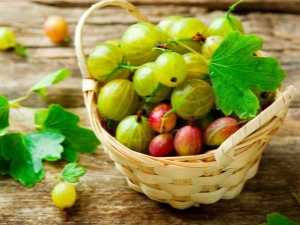What vitamins are contained in gooseberry?

The gooseberry is a garden shrub, the berries of which, although not the most beloved in adults and children, are as useful as raspberries or currants.The first mention of this shrub dates back to 1536, and it found distribution in many countries and continents, both as a cultivated and as a wild plant. The berry is endowed with a rich composition of nutrients, among which vitamins are essential.
Vitamin composition
When people talk about gooseberries, as a supplier of vitamins, they first of all indicate the rich presence of vitamin C in it (ascorbic acid). This component is known as an excellent assistant in the fight against colds and in creating a strong immunity. In addition, ascorbic acid is involved in the formation of blood cells and stimulates the endocrine glands.
Vitamin A (retinol) and its provitamin, contained in the gooseberry, are directly involved in the formation of the immune system. And also retinol is very useful for vision, facilitates the course of many diseases. Being a powerful antioxidant, vitamin A improves cell regeneration and inhibits the aging process of the body. The need for its presence is essential in the formation of teeth and bones.
Caratinoids, which are vitamin A provitamins, are found in large quantities in the red gooseberry and they give the berries a red color. One of the carotenoids, which is part of the gooseberry and called lutein, protects the fiber from the negative effects of ultraviolet rays, minimizes the risk of cataracts.
As part of the gooseberry is present almost the entire complex of vitamins B.
- Vitamin B1 (thiamine) normalizes the digestive, cardiovascular and nervous system. It is also a good stimulator of brain activity and blood formation, improves appetite. In general, B1 activates the work of all internal organs, is indicated for use after a long illness and for elderly people to maintain or resume vital activity. In addition, thiamin helps to deal with skin diseases of a nervous nature (psoriasis, pyoderma).
- Vitamin B2 (riboflavin) participates in the formation of hormones and red blood cells, is actively working to convert energy from carbohydrates and fats. His contribution to the creation of stress hormones, which helps to cope with stressful situations and their consequences, is especially noted.
Riboflavin is necessary for proper breakdown of fats, proteins and carbohydrates. In addition, B2 has a beneficial effect on the condition of the skin, giving it youth, elasticity and elasticity.
- Vitamin B3 (Niacin or PP) actively participates in redox processes, cell respiration, stabilizes the nervous system, prevents skin diseases, reduces pain. Further, PP significantly improves the cardiovascular system, lowers blood pressure, optimizes the value of cholesterol in the blood, improves the condition of the circulatory system, and is involved in the conversion of proteins and fats into energy.
- Vitamin B6 (pyridoxine) helps to absorb fatty acids productively, has an impact on the synthesis and activity of enzymes. It controls blood sugar jumps, normalizes brain activity and improves memory, increases efficiency. Pyridoxine also catalyzes the production of certain antidepressants (for example, serotonin and norepinephrine), which help to cope with depressive conditions.
- Vitamin B9 (folic acid) takes part in the synthesis of acids and enzymes, has a positive effect on the work of the liver and the functioning of the digestive system, helps to establish the correct functioning of the hematopoietic system
Vitamin B9 is involved in the transmission of signals by nerve cells. Folic acid is indispensable during pregnancy, participating in the formation of the nervous system of the child.
- Vitamin E (tocopherol) normalizes the reproductive work of men and women, has a beneficial effect on the endocrine and nervous system. Tocopherol is necessary for the smooth operation of the cardiovascular system, cleans the blood vessels of clots, acts as an obstacle to thrombus formation. This vitamin helps to recover after completing a course of chemotherapy. And also tocopherol is a powerful antioxidant, prevents early aging, makes the skin supple and prevents the formation of pigment spots.
- Vitamin P (rutin) found mainly in the red gooseberry. This vitamin works to strengthen the walls of blood vessels, prevents external bleeding and hemorrhagic diathesis, dilates blood vessels, eliminates blood clots. Rutin improves immunity, helps the body in the fight against viral diseases, combats inflammation, minimizes allergic reactions.
Other beneficial substances
Gooseberry berries are filled with biologically active substances. In addition to the vitamin group, they contain various carbohydrates (sucrose, glucose, fructose), organic acids (malic, citric, tartaric), nitrogenous and tannins, pectins and minerals.
The gooseberry mineral group is represented by the following macro- and microelements: potassium, phosphorus, sodium, calcium, sulfur, magnesium, iron, zinc, iodine, copper, manganese, chromium, molybdenum.
How to save vitamins for the winter
As you know, the season of gooseberry ripening is summer. This raises the question of how to preserve the unique benefits of the gooseberry for the winter period, since many vitamins are destroyed by heat treatment. Only vitamins such as C and PP are immune to the effects of high temperatures.
Other vitamins are well preserved during the preparation of raw gooseberry jam. To do this, the berries are crushed in a meat grinder, using a blender or food processor. Then they are mixed with sugar in a 1: 1 ratio, stirred to dissolve sugar, poured into cans and sent to storage in a refrigerator.
Harm and contraindications
It is undesirable to use gooseberries for people with diseases such as enteritis and diarrhea. This is due to the laxative effect of the berries on the digestive system, resulting in the leaching of nutrients from the body and its dehydration. In addition, the gooseberry is not recommended to use simultaneously with the plum. In this case, it is possible to observe incompatibility of products, the result of which will be diarrhea.
You also need to monitor the number of berries eaten and do not overdo it with the size of servings. Like any product, gooseberry is better to eat smaller portions, but more often. If the portions are too large, the digestive system will be harder to cope with them, which, in turn, can result in indigestion and allergic reactions.
For more information about the beneficial properties of gooseberry, see the following video.


























